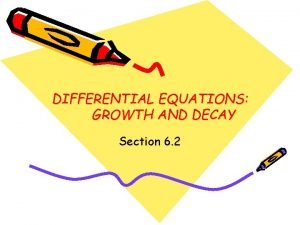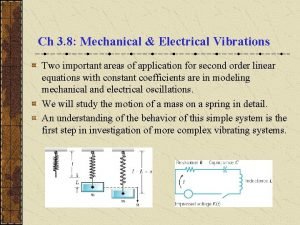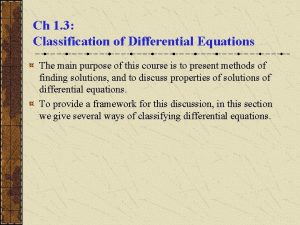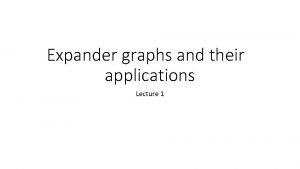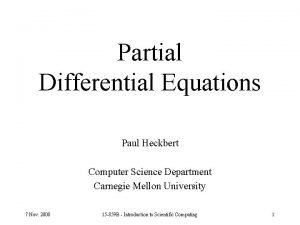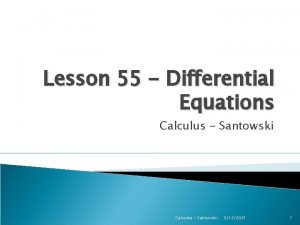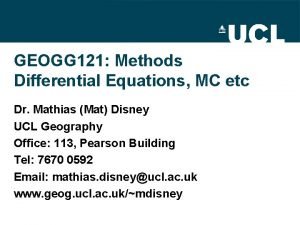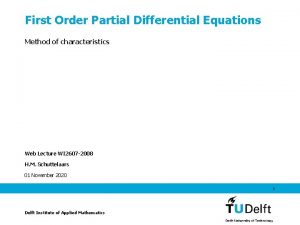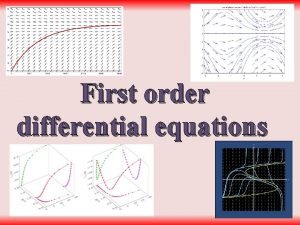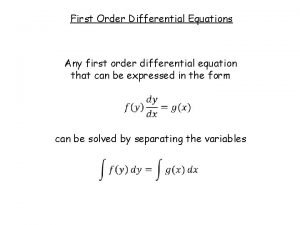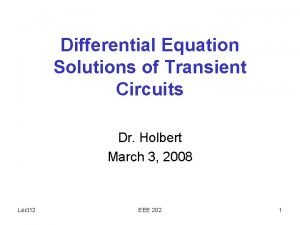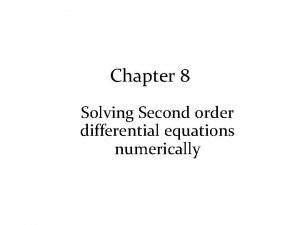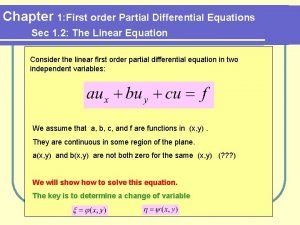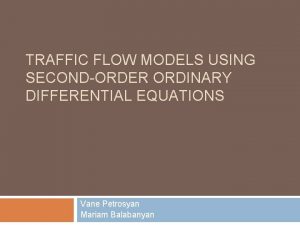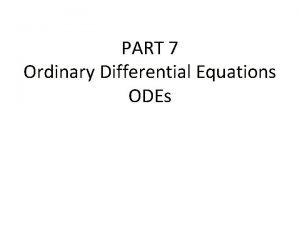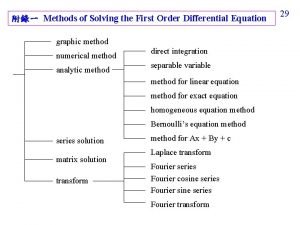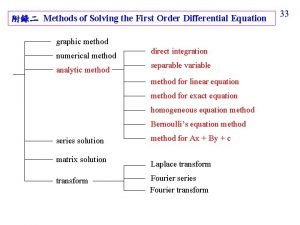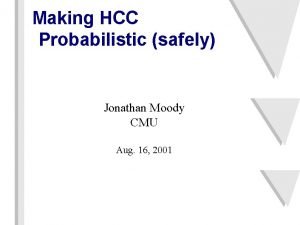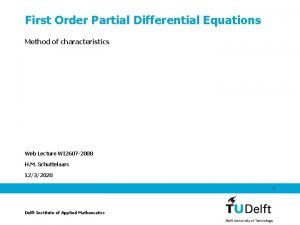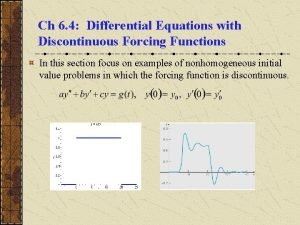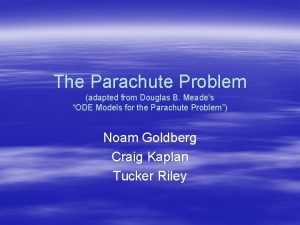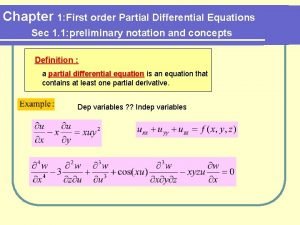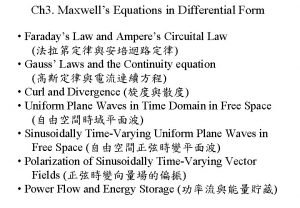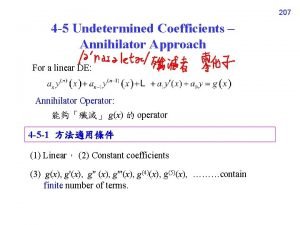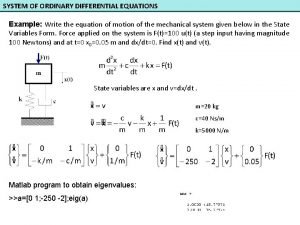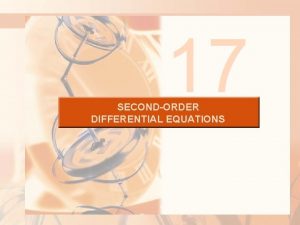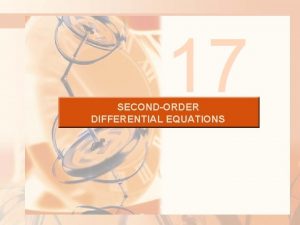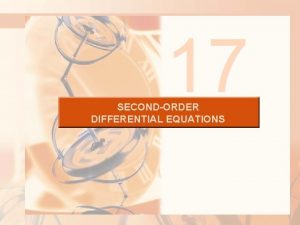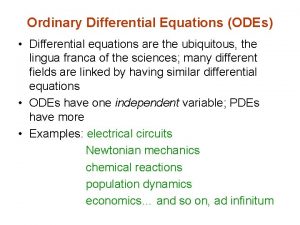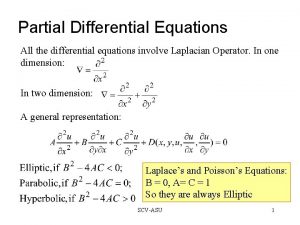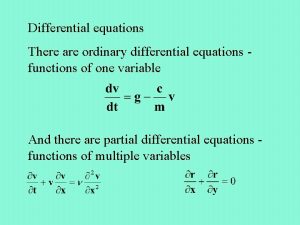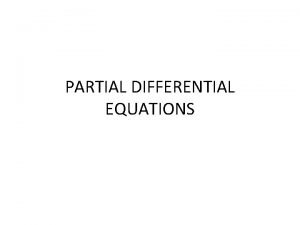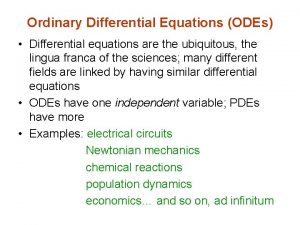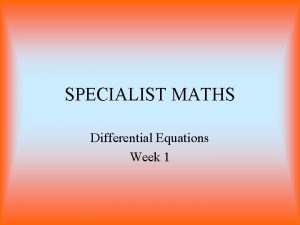Teaching Differential Equations and Their Applications Using Projects









































- Slides: 41

Teaching Differential Equations and Their Applications Using Projects, Online Resources, and More W. Y. Chan Texas A&M University – Texarkana JMM Baltimore, MD January 19, 2019

Outline of the Presentation �Topics Covered in a Differential Equations Course �Projects �Online Resources �More

Part 1: Topics Covered in Differential Equations Course

Differential equations is one of the required courses for some STEM majors. This course covers techniques for solving differential equations and their applications on various disciplines. To keep the balance of reaching both, homework problems and projects are assigned to help students understand principles and methods.

What Majors Need Differential Equations? � Southeast Missouri State University �Computer Science, Mathematics (optional), Physics, and Engineering Physics � Gonzaga University �Computer Science, Mathematics (optional), Physics, Engineering Program (Mechanical, Civil, Computer, Electrical) � Texas A&M University - Texarkana �Computer Science, Mathematics (required), Electrical Engineering • Pre-requisite of Differential Equations is Calculus II • Students taking this course are usually sophomores or juniors.

What Majors Need Differential Equations? • Textbook used � W. Boyce and R. Di. Prima, Elementary Differential Equations and Boundary Value Problems, Wiley, 8 th to 11 th editions, 20032013. � K. Nagle, E. Saff, and A. Snider, Fundamentals of Differential Equations and Boundary Value Problems, 6 th edition, 2011. � R. L. Borrelli and C. S. Coleman, Differential Equations: A Modeling Perspective, Wiley, 2004.

Process of Mathematical Modeling

Topics Covered in the Course of Differential Equations �First order differential equations, direction fields, principle of the existence of the solution �Different techniques of solving homogeneous first and second differential equations and finding particular solutions �Numerical methods �System of first order differential equations �Laplace Transform �Series of Solution (optional)

Radioactive Decay Some Applications of Differential Equations Spring Vibration Falling Objects

Topics Covered in the Course of Differential Equations �Applications of DE through introducing mathematical models (radioactive decay, population of entity, LRC electric circuits, oscillating pendulum, spring vibrations, falling object with air resistance) �Modeling with the first order differential equations, compartmental models (mixture problems) , logistic population models �It takes time to discuss the structure of the mathematical models.

Falling Objects with Air. Resistance

Falling Objects with Air. Resistance

�The resultant force acting on the object is F 1 + F 2 = mg + air-resistance �Apply the Newton’s second law

Parachute Jumping

Parachute Jumping

Parachute Jumping Model �Before opening the parachute where k 1 = 15 N-sec/m. The parachute opens at time 25 sec with k 2 = 105 N-sec/m, The total distance for this fall is 2000 m. The values of these ki’s are from textbook or other references.

Redesign the Parachute Jumping Model �In 2015, one student was very interested in this mathematical model after it was introduced in class. �This student was a veteran paratrooper. �He served in the US air force at (Fairchild Air Force Base in Washington State) for many years and did the parachute jumping for more than 40 times. �He investigated this problem and created his own mathematical models.

Redesign the Parachute Jumping Model - Abstract �USAF at Fairchild Air Force Base are using parachute systems designed for high altitude, high speed egress and openings. These parachutes are designed using parameters that cannot be recreated in a reasonable, safe or fiscally responsible sense. �The objective of his research is to develop differential models for these parachute systems and their functions using known design characteristics, and determine new or confirm actual parameters in the real-world deployment of these parachute systems. He focuses on lowaltitude, low-speed parachute deployment under a range of atmospheric conditions.

Redesign the Parachute Jumping Model – Mathematical Model �Before opening the parachute The parachute opens at time 4 sec,

Redesign the Parachute Jumping Model – Mathematical Model �Cm = 1/ft and CD = 1. 2/ft are coefficients of drag. �Af is frontal area of parachute: 249. 60 ft 2 �Am is frontal area of average human: 10. 23 ft 2 �Vm is volume of average human: 2. 34 ft 3 �rm is density of average human: 63. 68 lb/ft 3 �rf is density of air: 7. 30 x 10 -2 lb/ft 3 �The student obtained these parameters through other references or website.

�His mathematical model was presented in math club meeting (with a real parachute showing to the audiences), MAA sectional meeting, and National Conference on Undergraduate Research in 2015.

Part 2: Projects

Assigned Projects �Torricelli’s Law of Fluid Flow �Differential Equations and Baseball Batting �Direction Fields and Logistic Models �Optimal Time for Harvesting Catfish �Bungee jumping �Spread of disease using SIR mathematical model

Example

Example (continued)

Example (continued)

Solutions and Analysis �Most of the time, students spend time to solve models, analyze them, and understand the behavior of solutions. Then, they make conclusion based on the solutions.

Part 3: Online Resources

� Direction Fields https: //www. wolframalpha. com/input/? i=direction+field https: //www. geogebra. org/m/W 7 d. Adgqc https: //www. geogebra. org/m/QPE 4 Pa. DZ https: //www. desmos. com/calculator/eijhparfmd � Numerical Solver https: //reference. wolfram. com/language/tutorial/Numerica l. Solution. Of. Differential. Equations. html http: //www. math-cs. gordon. edu/~senning/desolver/ � Solving Differential Equations Videos https: //www. youtube. com/watch? v=q. W 1 Vgn. MRNBg https: //www. youtube. com/watch? v=z 3 Ag 8 WF 5 M_c https: //www. youtube. com/watch? v=p. YXp. Qqv. Tt. EM

https: //www. geogebra. org/m/W 7 d. Ad gqc

https: //www. desmos. com/calculator/e ijhparfmd

http: //www. mathcs. gordon. edu/~senning/desolver/

Part 4: More

�It would be a challenge to teach the whole process of mathematical modeling.

�To build a mathematical model to describe a real- world situation, students are also required to �list assumptions, it would take time to write reasonable assumptions; �list all variables; �determine the parameters of the model.

Mathematical Modeling Team Project - Example Heart Rate of Mammals—The following data relate the weights of some mammals to their heart rate in beats per minute. Based on the discussion relating blood flow through the heart to body weight, construct a model relating blood flow through the heart to body weight. Explain the detail to obtain this mathematical model. � This problem and data came from a text. �

Mammal Vespergo pipistrellas Mouse Rat Guinea pig Rabbit Little dog Big dog Sheep Man Horse Ox Elephant Body weight (g) 4 25 200 300 2000 5000 30000 50000 70000 4500000 3000000 Pulse rate (beats/min) 660 670 420 300 205 120 85 70 72 38 40 48

SCUDEM �We joined SCUDEM II and SCUDEM III in 2018. Students are able to practice the mathematical modeling process. SCUDEM II

SCUDEM III

Some Feedback After SCUDEM After the challenge for SCUDEM, I was able to learn how to create a differential equation using real life event … I learned that there is more ways to make a differential equation than the ones that are just given out of the book, like the homework problems we do for my differential equation class. Nathalie Alvarado, 2018

Thank you for your attention.
 Differential equations projects
Differential equations projects Non homogeneous differential equation
Non homogeneous differential equation Differential equations and linear algebra strang
Differential equations and linear algebra strang Growth and decay differential equations
Growth and decay differential equations Mechanical and electrical vibrations differential equations
Mechanical and electrical vibrations differential equations Classification of differential equations
Classification of differential equations N-ary relations and their applications
N-ary relations and their applications Expander graphs and their applications
Expander graphs and their applications Solid insulating materials and their applications
Solid insulating materials and their applications Scaled down teaching situation
Scaled down teaching situation Order and degree of differential equation ppt
Order and degree of differential equation ppt Classification of pde examples
Classification of pde examples Cengage differential equations
Cengage differential equations How to solve linear ode
How to solve linear ode Transient solution differential equations
Transient solution differential equations Differential calculus
Differential calculus Differential equation example
Differential equation example Separation of variables differential equations
Separation of variables differential equations Pde
Pde What is a first order equation
What is a first order equation Integrating factor of differential equation
Integrating factor of differential equation What is ordinary differential equation
What is ordinary differential equation Cengage differential equations
Cengage differential equations Natural solution
Natural solution How to solve second order differential equations
How to solve second order differential equations What is a first order equation
What is a first order equation Traffic flow differential equations
Traffic flow differential equations First order ordinary differential equations
First order ordinary differential equations Euler method formula
Euler method formula First-order linear equations
First-order linear equations First-order differential equations
First-order differential equations Slidetodoc
Slidetodoc Differential equations
Differential equations Differential equations with discontinuous forcing functions
Differential equations with discontinuous forcing functions Bernoulli differential equation
Bernoulli differential equation Parachute problem differential equations
Parachute problem differential equations Differential equations zill solutions
Differential equations zill solutions Stewart differential equations
Stewart differential equations Differential equations chapter 1
Differential equations chapter 1 Maxwell's equations differential form
Maxwell's equations differential form Annihilator method
Annihilator method Ordinary differential equations example
Ordinary differential equations example



